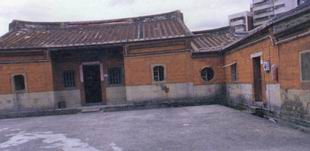 Huang Family Qianrang Estate
Huang Family Qianrang Estate When ancestors of the Huang clan, immigrants from Anxi in Quanzhou County, Fujian Province, arrived in Taiwan during the Qianlong era of the Qing dynasty (c. AD 1740), they first settled in Fanshuliao in the Tamsui area, later moving to this area, originally known as Longanpi. The fourth generation of the Huang clan pooled its manpower to build a traditional Chinese mansion along a footpath cutting through rice fields. They named it Lianrang Estate, subsequently renaming it Qianrang Estate.
Oriented toward the south, this traditional southern Fujian redbrick farmhouse with three sections had a central building with left and right wings. Initially single-section structures, the wings were later expanded to accommodate steady family growth. The original well, still found at the rear of the house, is of considerable historical significance. The estate, which is now part of the Longmen Junior High School campus, is used in its Taiwan Studies program.
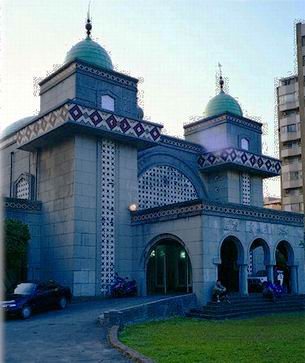 Taipei Grand Mosque
Taipei Grand Mosque
The Taipei Grand Mosque is Taiwan's most important Islamic structure and the center of the Muslim faith in Taiwan.
At the time of its construction, Taiwan enjoyed frequent exchanges with a number of Middle Eastern allies.
The then Minister of Foreign Affairs Ye Gong-chao proposed the building of the mosque and friendly Muslim countries contributed joint funding for the structure designed by architect Yang Chuo-cheng. A number of Muslim leaders and foreign dignitaries from countries around the world have worshipped here during their visits to Taiwan.
A unique cultural landmark of Taipei, the mosque has special cultural features reflecting the spirit of Islam. Its exterior design incorporates such architectural elements as the traditional dome, colonnade and minaret. The building’s layout includes a reception hall, a prayer hall, side arcades, offices, library, ablution hall and gardens.
The expansive prayer hall, with an interior height and width of 15 meters, can accommodate a large congregation. As Islamic architecture does not use representational depictions of animals, botanical and geometric patterns constitute the building’s decorative motifs, lending the setting a sense of elegant tranquility. 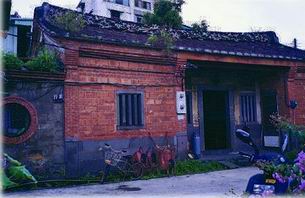 Fanglan Mansion
Fanglan Mansion
Fanglan Mansion was the first domicile of the Chen family when they immigrated to Taiwan from Anxi in Quanzhou County, Fujian Province. They later constructed two other estates, New Fanglan Mansion (since demolished) and Yifang Mansion. Each of the structures was built with its back to the Chanchu Mountain at a high, easily defensible elevation, reflecting the perils of early pioneer life.
The original Fanglan Mansion was a traditional three-sectioned structure, composed of a central building and left and right wings. Construction materials included local stones, and bricks and fir wood shipped from mainland China. A waterwheel attached to one of the exterior walls was decorated with clay moldings. Earthen Chinese characters decorated the top parts of doors and windows; the intricacy of the workmanship is still evident. After collapses, the building's two wings no longer remain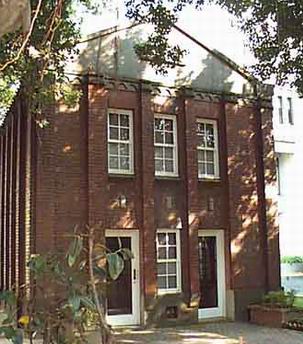 Taipei School of Industry “Red Building”
Taipei School of Industry “Red Building”
The Taipei School of Industry, established as the Lecture Hall of Industry, operating under the colonial Department of Civil Administration during the era of Japanese rule (1895-1945), was reincorporated as the Provincial School of Industry in 1921. In its day acknowledged as the most prestigious industrial school in Taiwan, it offered courses in chemical engineering, electrical engineering, mechanical engineering and architecture, and played a key role in shaping the Japanese colonial government’s industrial policy.
The school buildings were mostly of red brick and wood, but reinforced concrete structures replaced them over the years. Only one group of red brick buildings remains today, standing as valuable historical evidence of the school’s original appearance. The structures were two stories in height, long and slender in shape, with protruding columns. Air vents under the window sills were made of molded iron and engraved with the Provincial School of Industry logo. The masonry was of uniformly high quality, reflecting the era’s design aesthetic based on strict proportions.
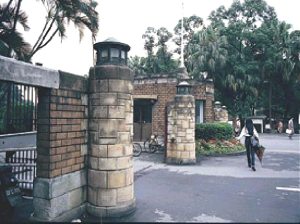 National Taiwan University Main Gate
National Taiwan University Main Gate
Originally the front gate of Taihoku Imperial University, Taiwan's highest institution of learning, and a city landmark, the main gate of National Taiwan University is still regarded as a symbol of the island’s extensive colonization by Japan, and of the history of higher education in Taiwan.
Designed by the Japanese colonial government's civil engineering department, the structure was intimate in scale and simple in appearance. The central guardhouse allowed gatekeepers to control pedestrians and vehicles entering and leaving the campus’s main drive, which was lined with coconut trees. The structure was constructed with brown-faced bricks produced in Taipei and stones from nearby Qili'an, giving it a distinctive local flavor.
The design of the gate was harmoniously coordinated with other campus buildings of the time period. The plaza in front of the gate has served for decades as a forum, where young students gather to voice their concerns and call for social reform.
The Old Air Force Headquarters
The Old Air Force Headquarters is located at No. 55, Section 3, Renai Road. The Taiwan Sotokufu Chūō Kenkyuusho (Taiwan governor generalship industrial research center) was established in 1939 (14th year of the reign of Emperor Showa), and the Second Building (originally the industrial research center) was constructed in 1940. When Taiwan was formally transferred to the Taiwan Provincial Government in 1945, the organization was renamed as Industrial Research Center at Da’an. In 1949, due to pressing concerns of national defense, several buildings of the Da’an research center was leased to the Air Force to be used as the latter’s headquarters. On September 14, 2015, the building was officially established as the Old Air Force Headquarters, a historical monument and building of Taipei City.
The Old Air Force Headquarters was located at what used to be the Taiwan Sotokufu Chūō Kenkyuusho (Taiwan governor generalship industrial research center). The Old Office Building at the center of the site used to be Building 2 of the industrial research center, and is now one of the few remaining buildings of the 4 research centers built by the Taiwan Sotokufu (Taiwan Governor Generalship). This surviving building serves as an important testament to the efforts of industrialization driven by the Japanese colonial government in Taiwan.
In the 1950s, the site was converted to the Air Force Headquarters and used by the Republic of China for research and defense purposes. Nevertheless, the 1940 appearances of the building were preserved. Both the industrial research center during the Japanese Occupation and the decommissioned Air Force Headquarters have served as key institutions in the history of Taiwan. This area has a history dating back 70 years and reflected urban development patterns in Taipei City, starting as a quiet suburban backwater in the eastern regions to become one of the most bustling commercial areas of the City.
The Old Office Building has been officially designated as a historical monument. The Building featured modern architectural lexicon and functional designs. The east and west facades were inclined by 45 degrees to reduce direct exposure to sunlight along said directions. Internal layouts included a central corridor that served as the main defining feature and a number of branch walkways along the corridor, providing great practicality. The front door and side door feature unique guard houses. The military intelligence building and 2 air raid shelters were also registered as historical structures as they provide special military value and serve as testaments to American military aid after World War II.

![Taiwan.gov.tw [ open a new window]](/images/egov.png)
